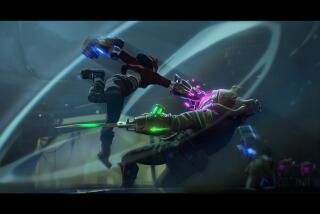How the ‘Avengers: Endgame’ video game crossover got a ‘Fortnite’ holdout to succumb
- Share via
For once, I had something in common with Thor.
As someone who has spent more time wielding a game controller rather than a battle ax and spinning vinyl records instead of giant shield, a superhero physique was never in my future. Chris Hemsworth’s character would have to come down to my world.
In “Avengers: Endgame” he does just that, bemoaning his fortunes, playing a video game and drinking a beer. A superhero never seemed so … real.
That scene in “Endgame” contributes to a cross-medium promotion between Disney-owned Marvel and Epic Games, the latter the developer of “Fortnite,” the hottest video game of the last few years, as well as the creator of the Unreal Engine, the tech that not only drives many a game but will power the interactive Millennium Falcon attraction opening in the weeks ahead at Disneyland and Florida’s Walt Disney World.
And in a further merging of the two most powerful entertainment blockbusters in 2019, as part of this week’s updates to “Fortnite,” players have been battling Thanos and prowling for Avengers weapons.
Though the plan is for this makeover to disappear from “Fortnite” at the end of this weekend, one important distinction must be made: The tweaks bring the characters of the Marvel Cinematic Universe to the world of “Fortnite” and not the other way around — the play experience is still deeply rooted in all things “Fortnite” rather than the world of the Avengers.

Iron Man and Black Widow rule the box office, but there may be only one pop-culture entity to which Marvel would still be willing to bow before, and that apparently is “Fortnite.” While “Endgame” brought in $1.2 billion its first weekend at the global box office, “Fortnite,” whose popular, free-to-play battle royale mode first hit the market in late 2017, is estimated to have brought in $2.4. billion last year, according to published reports citing Nielsen’s SuperData Research.
And with the “Avengers” presence in the game concluding this weekend, this campaign likely means more to cementing “Fortnite’s” brand than it does in boosting “Endgame’s” reach, giving the game, however popular it may be, a potential boost of newcomers just as fresh titles such as “Apex Legends” come vying for the “Fortnite” crown.
I would know — I’m one of them.
As someone who is not among the 250 million-plus who are estimated to have given “Fortnite” a try, I succumbed this week. If it’s good enough for Thor, maybe it’s good enough for me?
There are reasons I held out, many of them doing with my desire to play — and fail — solo or with trusted friends. And since none of my friends play online games, save the occasional “Mario Kart” race, the spectator-focused worlds of competitive shooters and e-sports are not ones I visit often.
In other words, I am bad at them — terribly bad. And when you’re bad, the joy I find in gaming — constructing my own narrative around challenges or a game’s plot — can never develop.
Last but not least, I classify “Fortnite” as a sport, and I decided long ago that professional sports were often not things I should be participating in. While it’s true that there is a sense of coordination, dexterity and strategic concentration required to the mastery of “Fortnite,” that wasn’t how I came to realization that e-sports should be viewed on par with football, soccer, baseball and others.
It was a feeling — being shot in the head in a game like “Fortnite” creates the very same sensation I had when I dropped a ball in Little League. Unlike a difficult game such as “Dark Souls” or “Cuphead,” there is no pattern to study and conquer — “Fortnite” requires one surrender not to randomness but to the understanding that there will forever simply be players who are better than you.
In those moments where I’ve been shot, there’s a nagging sensation that I let my team down. In turn, I want to shut the whole thing off and hide in my room. Without having experienced this, I contend it’s difficult for some to consider “Fortnite” a sport.
“Avengers: Endgame” gets a relatively cheap laugh out of a moment with Thor and pals doing battle with presumably teenage “Fortnite” opponents. The audience chuckles not because Thor can be bested by a kid; the young, after all, excel in all sports, so that’s nothing exclusive to gaming.
The laugh comes from the wink the film is giving the audience. This game that you don’t understand, it says, is silly — so silly it can be mastered by anyone, not superhumans like Mike Trout and Christian Yelich — and not even Thor. But with the largest of e-sports events starting to surpass more than 100 million global viewers, that’s a joke that isn’t going to age well.
So that’s how and why I’ve avoided the biggest gaming phenomena of the moment. About three years into its lifetime, “Fortnite” is well established and comes with its own language of written and unwritten rules. I don’t believe in showing up at Dodger Stadium in cleats and demanding to pitch the seventh inning, and I don’t want to log into a game where I’m dead-on-arrival as far as my team is concerned.
Now here’s how “Endgame” got me in. Though it’s possible to just go solo and hope to be the last person standing in a “Fortnite” match, the game excels when played with squads, friends grouped together as a mini team. The strategy increases, and so does the social aspect.
I am forever squadless.
With “Endgame,” however, the tone changed. I am not just a lone gunner or a friendless dweeb. The rules are clearly defined as good versus evil from the beginning. If I’m among those aligned with Thanos, I essentially turn into an anonymous member of a metallic, slightly purple-crayon-toned warrior species known as the Chitauri. If I’m on Team Avengers, I’m launched with a couple decent weapons and go on the hunt for prizes such as Thor’s ax.
This limited-time mode — the second such pairing between the Avengers and “Fortnite” — feels like the sort of crucial modification that should stick around. “Fortnite” can be punishing to newcomers. Its anything-goes, last-person-standing approach creates a constant sense of panic that makes learning the game against superior players feel like an impossible hurdle.
Not as much with “Endgame,” as everyone, good or bad, gets either colorful lasers or the ability to access superhero weapons such as Captain America’s shield, lending a bit more zaniness and unpredictability to the proceedings. With such spontaneity, it may not be the mode of choice for the game’s pros, but for those who have been on the “Fortnite” sidelines it lends the game a sense of approachability, an ever so slight leveling of the playing field.
Still, it was always clear I was partaking in “Fortnite” rather than a superhero game. There were goofy dances, outrageous costumes and hastily constructed forts. But the we’re-all-in-this-together brand messaging of “Avengers” carried over, and suddenly “Fortnite” wasn’t as cutthroat and oppressive to the lesser experienced. I’m not saying it made me a full-fledged “Fortnite” convert. After all, this week also gave us new puzzles via the charming “BoxBoy! + BoxGirl!”
But video games or Marvel movies can often pander by using insufferable fan-service tactics — nods or references that appeal only to those well-versed in a product’s lore. Yet “Fornite” succeeded this week in achieving something that arguably not even the film that inspired its “Endgame” mode can claim: It extended a hand to a newcomer.
Follow me on Twitter: @toddmartens
More to Read
The biggest entertainment stories
Get our big stories about Hollywood, film, television, music, arts, culture and more right in your inbox as soon as they publish.
You may occasionally receive promotional content from the Los Angeles Times.











